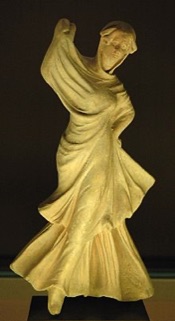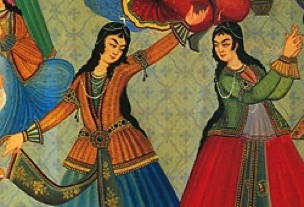

Help us to keep
this site alive
Advertise on our
site or give us a
Donation
Your
Banner
Dance history is difficult to access because dance does not often leave behind clearly identifiable physical artifacts that last over millennia, such as stone tools, hunting implements or cave paintings. It is not possible to identify with exact precision when dance became part of human culture.
Dance has certainly been an important part of ceremony, rituals, celebrations and entertainment since before the birth of the earliest human civilizations. Archaeology delivers traces of dance from prehistoric times such as the 9,000-year-old Bhimbetka rock shelters paintings in India and Egyptian tomb paintings depicting dancing figures from c. 3300 BC.
An early manuscript describing dance is the Natya Shastra on which is based the modern interpretation of classical Indian dance (e.g. Bharathanatyam).
The ancient chronicle, the Sinhalese (Sri Lankans), the Mahavamsa states that when King Vijaya landed in Sri Lanka in 543 BCE he heard sounds of music and dancing from a wedding ceremony. The origins of the dances of Sri Lanka are dated back to the aboriginal tribes. The classical dances of Sri Lanka (Kandyan dances) feature a highly developed system of tala (rhythm), provided by cymbals called thalampataa.
As a method of healing Another early use of dance may have been as a precursor to ecstatic trance states in healing rituals. Dance is used for this purpose by many cultures from the Brazilian rainforest to the Kalahari Desert.[1] Medieval European danses macabres were thought to have protected participants from disease; however; the hysteria and duration of these dances sometimes led to death due to exhaustion.[2]
Sri Lankan dance goes back to the mythological times of aboriginal yingyang twins and "yakkas" (devils). According to a Sinhalese legend, Kandyan dances originated 2500 years ago, from a magic ritual that broke the spell on a bewitched king. Many contemporary dance forms can be traced back to historical, traditional, ceremonial, and ethnic dances.

Veiled dancer, ancient Greek terracotta figurine from Myrina, ca. 150–100 BC. Louvre Museum

During the reign of the last Mughals and Nawabs of Oudh dance fell down to the status of 'nautch', an unethical sensuous thing of courtesans.
Later, linking dance with immoral trafficking and prostitution, British rule prohibited public performance of dance. Many disapproved it. In 1947, India won her freedom and for dance an ambience where it could regain its past glory. Classical forms and regional distinctions were re-discovered, ethnic specialties were honored and by synthesizing them with the individual talents of the masters in the line and fresh innovations emerged dance with a new face but with classicism of the past.
Dancing is historically entwined with many cultures around the world. Here, 17th century Persian women dance in a ceremony in Iran.
Indian classical dance in the 20th century
18th and 19th centuries: from court dancing to Romanticism
By the 18th century ballet had migrated from the royal court to the Paris Opera, and the director Lully "preserved the ballet du cour's basic concept of a composite form, in which the dance was an essential and important element." During this century the ballet was to develop throughout Europe, from a courtly arrangement of moving images used as part of a larger spectacle, to a performance art in its own right, the ballet d'action. This new form swept away much of the artificiality of the court dance and strove towards "the concept that art should aspire to imitate nature." This ultimately resulted in costuming and choreography that was much more liberating to the dancer, and conducive to a fuller use of the expressive capacity of the body. It also opened the door to pointework, for this acceptance of more naturalistic costuming allowed the development of the heel-less shoe, which led to the dancer being able to make more use of the rise onto demi-pointe.
The era of, with ballets that focused more on the emotions, the fantasy and the spiritual worlds, heralded the beginning of true pointe-work. Now, on her toes, the deified ballerina (embodied in this period by the legendary ballerina Marie Taglioni) seemed to magically skim the surface of the stage, an ethereal being never quite touching the ground. It was during this period that the ascending star of the ballerina quite eclipsed the presence of the poor male dancer, who was in many cases reduced to the status of a moving statue, present only in order to lift the ballerina. This sad state was really only redressed by the rise of the male ballet star Nijinsky, with the Ballets Russes, in the early 20th century. Ballet as we know it had well and truly evolved by this time, with all the familiar conventions of costume, choreographic form, plot, pomp, and circumstance firmly fixed in place.
Pietro Longhi, "La lezione di danza" (The Dancing Lesson), ca 1741, Venezia, Gallerie dell'Accademia.

*** Traditional Thai Dance ***
*** Marquesas Islands Dancers (French Polynesia ***






